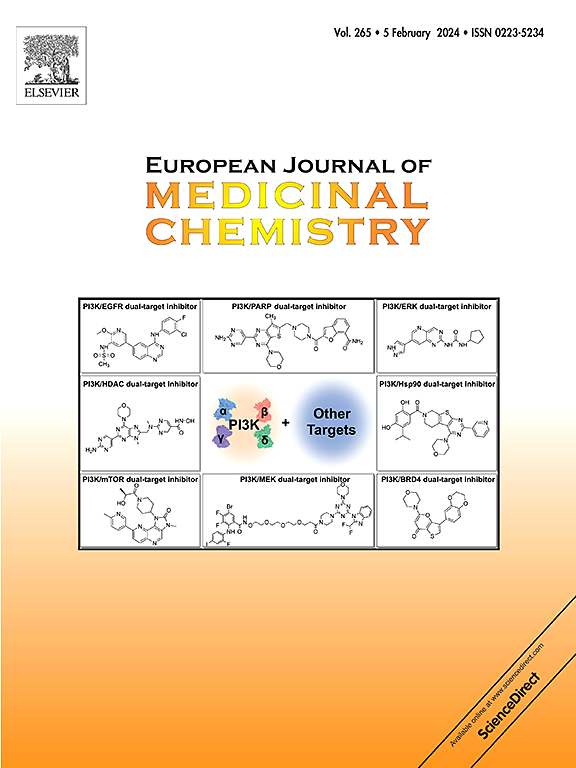Poly(ADP-ribose) polymerase-1 (PARP1)-based dual inhibitors targeting cancer synthetic lethality (2022-present): advances and perspectives
IF 6
2区 医学
Q1 CHEMISTRY, MEDICINAL
引用次数: 0
Abstract
Poly(ADP-ribose) polymerase 1 (PARP1), a critical enzyme in DNA damage repair (DDR) and genome stability maintenance, has emerged as a pivotal therapeutic target in oncology. PARP1 inhibitors (PARPi) exploit synthetic lethality to selectively target homologous recombination repair (HRR)-deficient cancer cells, revolutionizing treatment for patients with breast cancer susceptibility gene 1/2 (BRCA1/2) mutations and other DNA repair defects. However, monotherapy resistance and limited efficacy in broader patient populations necessitate innovative strategies. Recent advances highlight the promise of dual-targeting inhibitors that simultaneously inhibit PARP1 and additional oncogenic drivers (e.g. GFR, CDK, NRP1, Polθ, ALR2, Ras or FTase) to amplify antitumor effects and overcome resistance mechanisms. This review comprehensively examines dual inhibitors relevant to PARP1 in literature not covered in the last review, analyzing their design rationales, structure-activity relationships (SARs), pharmacological activities and synthetic pathways, and more. Furthermore, the challenges in balancing dual inhibitors' potency, in obtaining optimal pharmacokinetics, and in minimizing off-target effects also were discussed. By integrating mechanistic insights with drug discovery trends, this work provides a roadmap for developing next-generation PARP1-based therapies, offering strategic guidance to enhance therapeutic outcomes and expand clinical applicability in heterogeneous malignancies.


基于聚(adp -核糖)聚合酶-1 (PARP1)的双重抑制剂靶向癌症合成致死率(2022年至今):进展与展望
聚(adp -核糖)聚合酶1 (PARP1)是DNA损伤修复(DDR)和基因组稳定性维持的关键酶,已成为肿瘤治疗的关键靶点。PARP1抑制剂(PARPi)利用合成致死性选择性靶向同源重组修复(HRR)缺陷的癌细胞,彻底改变了乳腺癌易感基因1/2 (BRCA1/2)突变和其他DNA修复缺陷患者的治疗方法。然而,单一疗法的耐药性和在更广泛的患者群体中有限的疗效需要创新的策略。最近的进展强调了双靶向抑制剂的前景,这些抑制剂可以同时抑制PARP1和其他致癌驱动因子(如GFR、CDK、NRP1、Polθ、ALR2、Ras或FTase),以增强抗肿瘤作用并克服耐药机制。这篇综述全面研究了上次综述中未涉及的与PARP1相关的双抑制剂,分析了它们的设计原理、构效关系(SARs)、药理活性和合成途径等。此外,在平衡双重抑制剂的效力,在获得最佳的药代动力学,并在尽量减少脱靶效应的挑战也进行了讨论。通过将机制见解与药物发现趋势相结合,这项工作为开发下一代基于parp1的疗法提供了路线图,为提高治疗效果和扩大异质恶性肿瘤的临床适用性提供了战略指导。
本文章由计算机程序翻译,如有差异,请以英文原文为准。
求助全文
约1分钟内获得全文
求助全文
来源期刊
CiteScore
11.70
自引率
9.00%
发文量
863
审稿时长
29 days
期刊介绍:
The European Journal of Medicinal Chemistry is a global journal that publishes studies on all aspects of medicinal chemistry. It provides a medium for publication of original papers and also welcomes critical review papers.
A typical paper would report on the organic synthesis, characterization and pharmacological evaluation of compounds. Other topics of interest are drug design, QSAR, molecular modeling, drug-receptor interactions, molecular aspects of drug metabolism, prodrug synthesis and drug targeting. The journal expects manuscripts to present the rational for a study, provide insight into the design of compounds or understanding of mechanism, or clarify the targets.

 求助内容:
求助内容: 应助结果提醒方式:
应助结果提醒方式:


